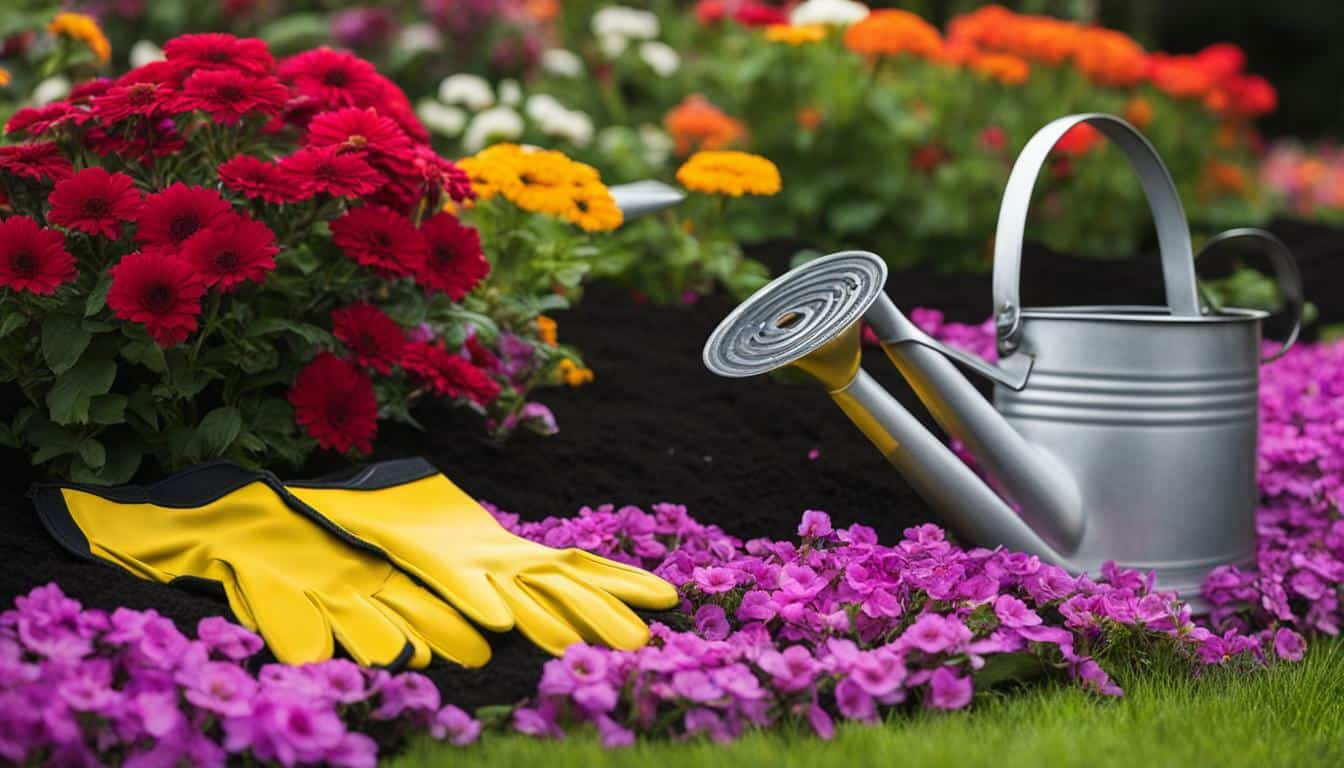Welcome to your ultimate guide for flower garden care! With these tips and tricks, you’ll be able to create and maintain a stunning flower garden that will bloom beautifully throughout the year. Whether you’re a beginner or have some experience with gardening, this guide will provide you with the knowledge and practices to ensure your flower garden thrives.
Key Takeaways:
- Choosing the right location for your flower garden is crucial for its success.
- Preparing the soil properly before planting will create a fertile environment for your plants to grow.
- Selecting the right plants that are suitable for your garden’s climate and light requirements is essential.
- Proper watering techniques, such as deep watering and avoiding foliage watering, will keep your plants healthy.
- Maintaining your flower garden by controlling weeds, deadheading spent flowers, and dealing with pests and diseases is key to its overall health.
By following these tips and incorporating them into your flower garden care routine, you’ll be able to enjoy a vibrant and flourishing garden that will bring joy to your home and surroundings.
Choosing the Right Location for Your Flower Garden
When it comes to caring for your flower garden, choosing the right location is crucial. Let’s explore the factors you need to consider to ensure optimal growth and blooming for your beloved flowers.
The first step in selecting a location is to assess the amount of sunlight your garden will receive. Most flowers require at least six hours of direct sunlight each day, so choose an area that is not obstructed by trees or buildings. Consider the direction of the sun and how it will move throughout the day to ensure your flowers receive adequate light.
In addition to sunlight, access to water is essential for your flower garden’s health. Choose a location that is easily reachable for regular watering. If possible, consider installing a drip irrigation system to provide a consistent water supply. Adequate drainage is also important to prevent waterlogging and root rot, so avoid areas with poor drainage or standing water.

Lastly, take into account environmental factors that can affect your flower garden. Consider the average temperature and climate in your region, as certain flowers thrive in specific conditions. Some flowers, for example, may need protection from strong winds or excessive heat. Understanding these factors will help you select the right plants for your garden and create an environment that promotes their growth.
By carefully considering these factors when choosing the location for your flower garden, you will set the foundation for a thriving and beautiful display of blooms. Remember to regularly assess your garden’s health and make necessary adjustments to ensure your flowers continue to flourish.
Preparing the Soil for Planting
Before you start planting, it’s essential to prepare the soil in your flower garden. Let’s dive into the step-by-step process to ensure your plants have the best foundation for growth and vitality.
- Remove weeds: Clearing your garden of weeds is crucial as they compete with your flowers for nutrients and water. Take the time to pull out any visible weeds, ensuring you remove the roots to prevent regrowth.
- Add organic matter: Enhance the soil’s fertility by incorporating organic matter such as compost or well-rotted manure. This improves drainage, retains moisture, and provides essential nutrients for your flowers to thrive.
- Loosen the soil: Use a garden fork or tiller to loosen the soil and break up any compacted areas. This allows air, water, and roots to penetrate the soil more effectively, promoting healthy growth.
- Avoid over-amending: While organic matter is beneficial, avoid adding too much as it can disrupt the balance of nutrients in the soil. Follow the recommendations on the product packaging or consult with local gardening experts for guidance.
By following these steps, you’ll create an ideal environment for your flower garden to flourish. Take the time to prepare the soil properly, and you’ll be rewarded with vibrant blooms and healthy plants.
“Properly preparing the soil is the foundation for a successful flower garden journey.”
Soil pH and Testing
It’s also essential to consider the pH level of your soil before planting. Most flowers prefer slightly acidic to neutral soil, with a pH range between 6.0 and 7.0. You can purchase a soil testing kit or send a sample to a local extension office for analysis. If your soil’s pH is outside the desired range, you can make adjustments by adding organic amendments or pH modifiers, such as sulfur or lime.
| Soil Type | Optimal pH Range |
|---|---|
| Sandy | 6.0-6.5 |
| Clay | 6.5-7.0 |
| Loamy | 6.0-7.0 |
Remember, each flower variety may have specific soil requirements, so it’s always best to research the preferences of the plants you intend to grow. Understanding and adjusting the soil pH will help provide the ideal conditions for your flowers to thrive.

Creating a healthy foundation for your flower garden is key to its long-term success. With proper soil preparation and a good understanding of your plants’ needs, you’ll be well on your way to cultivating a vibrant and thriving garden.
Selecting the Right Plants for Your Flower Garden
The key to a magnificent flower garden lies in choosing the right plants. Let’s explore some expert tips to help you make the best choices for your unique garden space.
When selecting plants for your flower garden, it’s important to consider their specific light requirements. Some plants thrive in full sun, while others prefer partial shade. Take note of the amount of sunlight your garden receives throughout the day and choose plants accordingly. This will ensure that your plants receive the optimal amount of light to grow and bloom.
Another factor to consider is the bloom time of the plants. By selecting a variety of plants with different blooming periods, you can ensure that your garden remains vibrant and colorful throughout the entire growing season. Include plants that bloom in early spring, summer, and fall to create a dynamic and visually appealing garden.
It’s also crucial to choose plants that are well-suited to your local climate. Consider the average temperature, humidity levels, and typical weather conditions in your area. By selecting plants that are native or adapted to your region, you increase their chances of thriving and reduce the risk of disease or pest infestations.

| Plant Name | Light Requirements | Bloom Time | Climate Adaptability |
|---|---|---|---|
| Rose | Full sun | Spring, summer | Varies by variety |
| Tulip | Full sun to partial shade | Spring | Thrives in cool climates |
| Lavender | Full sun | Summer | Tolerates dry, hot climates |
| Hydrangea | Partial shade | Summer, fall | Adaptable to various climates |
Expert Tip: Combine Colors and Textures
To create an eye-catching flower garden, consider combining plants with different colors and textures. Pair vibrant blooms with foliage that offers contrasting shades or interesting shapes. This will add visual interest and depth to your garden, making it a stunning focal point in your outdoor space.
Watering Your Flower Garden
Proper watering is essential for the health and vitality of your flower garden. Let’s discover the best practices to keep your blooms hydrated and thriving.
When it comes to watering your flower garden, it’s important to find the right balance. Overwatering can lead to root rot and other issues, while underwatering can cause wilting and stunted growth. The key is to water deeply and infrequently, allowing the water to reach the root zone.
To determine when your garden needs watering, follow this simple rule: Stick your finger in the soil up to the second knuckle. If it feels dry at that depth, it’s time to water.
Consider using a soaker hose or drip irrigation system to provide a slow, steady flow of water directly to the roots, minimizing evaporation and preventing water waste. This method also helps keep the foliage dry, reducing the risk of fungal diseases.
| Watering Tips: |
|---|
| Water your garden early in the morning to allow excess moisture on the leaves to evaporate throughout the day. This helps prevent fungal growth. |
| Avoid watering in the evening as the plants may stay wet overnight, increasing the chances of disease. |
| Consider using a rain gauge to monitor how much water your garden is receiving naturally. Aim for around 1 inch per week, adjusting based on weather conditions. |
| Use mulch around your plants to help retain moisture in the soil and reduce weed growth. Organic mulches like bark chips or compost also add nutrients to the soil as they break down. |
With these watering tips in mind, you can ensure your flower garden receives the right amount of water while promoting healthy growth and beautiful blooms.

Keeping your flower garden in top shape requires regular maintenance. Let’s explore the essential tasks you need to perform to ensure your garden remains vibrant and healthy.
First and foremost, it is important to control weeds in your flower garden. Weeds compete with your plants for nutrients, water, and sunlight, hampering their growth. Regularly inspect your garden and remove any weeds by pulling them out from the root. Use a gardening tool, such as a hand trowel or hoe, to make the task easier and more efficient. By keeping weeds at bay, you allow your flowers to flourish without unnecessary hindrances.
Deadheading spent flowers is another crucial maintenance task. As blooms fade and die, it is important to remove them to keep your garden looking fresh and neat. Deadheading not only improves the aesthetic appeal of your flower garden but also encourages new bloom production. Pinch or cut off faded flowers just above the first set of healthy leaves or above a bud to promote continuous blooming throughout the season.
In addition to weed control and deadheading, supporting tall plants is essential for maintaining the structural integrity of your flower garden. Wind and heavy rains can cause tall plants to bend or even break. To prevent this, use stakes, trellises, or cages to provide support and stability. Gently tie the stems to the supports, ensuring they are secure but not constricted. By offering adequate support, you protect your plants from damage and enable them to reach their full potential.

| Common Pests | Prevention and Control |
|---|---|
| Aphids | Use insecticidal soap or a strong spray of water to remove aphids from your plants. Encourage beneficial insects like ladybugs to control aphid populations naturally. |
| Slugs and Snails | Keep your garden clean and free of debris that provides hiding places for slugs and snails. Set up barriers like copper tape or diatomaceous earth around your plants to deter them. Handpick and dispose of slugs and snails regularly. |
| Fungal Diseases | Ensure proper spacing between plants to promote good air circulation. Water your garden early in the day, avoiding overhead watering, to allow foliage to dry quickly. Use fungicides as a last resort if necessary. |
Lastly, it is important to be aware of common pests and diseases that can affect your flower garden. Regularly monitor your plants for signs of pest infestations, such as aphids or slugs, and take appropriate measures to prevent and control them. Introduce natural predators or use organic insecticides to combat pests while minimizing harm to beneficial insects. Additionally, keep an eye out for fungal diseases, such as powdery mildew or black spot, and take preventive actions such as proper spacing, watering practices, and timely treatment if needed.
By following these essential maintenance tasks, your flower garden will thrive and bring you joy throughout the growing season. Take pride in nurturing your plants and enjoy the beauty they bring to your outdoor space.
Assessing Your Flower Garden’s Health
Regularly evaluating the health of your flower garden is crucial for its long-term success. Let’s discover the key aspects to consider when assessing the well-being of your beloved blooms.
One of the first things to observe is the overall appearance of your plants. Look for signs of wilting, discoloration, or stunted growth, as these could indicate nutrient deficiencies, pests, or diseases. Take note of any unusual spots, holes, or webbing on the leaves, as these may be signs of infestation.
Next, pay attention to the blooms. Are they vibrant and abundant, or are they sparse and dull? Take note of any flowers that fail to open or have irregular shapes. Additionally, monitor the presence of bees, butterflies, and other pollinators in your garden, as their absence could suggest an imbalance in your ecosystem.
It’s also important to check the soil moisture levels regularly. Stick your finger into the soil and assess its moisture content. Dry soil may indicate the need for more frequent watering, while overly wet soil could be a sign of poor drainage or overwatering. Maintaining proper soil moisture is essential for the health and growth of your plants.

Lastly, take time to inspect your garden for weeds. Weeds compete with your flowers for nutrients, water, and sunlight, and can quickly overtake your garden if left unchecked. Pull any weeds you find, ensuring you remove their roots to prevent regrowth.
| Aspect | Observations |
|---|---|
| Plant Appearance | – Wilting, discoloration, stunted growth – Unusual spots, holes, webbing |
| Bloom Quality | – Vibrant, abundant blooms – Flowers failing to open or irregular shapes |
| Pollinator Presence | – Bees, butterflies, other pollinators – Absence of pollinators |
| Soil Moisture | – Dry soil indicating the need for more water – Overly wet soil indicating poor drainage or overwatering |
| Weed Infestation | – Presence of weeds competing with flowers for resources |
By regularly assessing these aspects of your flower garden’s health, you can promptly address any issues that arise and ensure your blooms thrive year-round. Implementing appropriate solutions, such as adjusting watering schedules, applying organic fertilizers, or using natural pest control methods, will help maintain the beauty and vitality of your flower garden.
Dealing with Common Flower Garden Care Challenges
Even the most well-tended flower gardens can face challenges along the way. Let’s explore effective strategies to overcome common issues and keep your garden thriving.
One common challenge in flower garden maintenance is dealing with nutrient deficiencies. Poor soil quality or inadequate fertilization can hinder the growth and health of your plants. To tackle this, I recommend conducting a soil test to determine which nutrients are lacking. Based on the results, you can choose the appropriate fertilizers or organic amendments to replenish the nutrients your plants need. Remember to follow the instructions on the product labels for best results.
Another challenge that beginners often face is fungal infections and plant diseases. These can manifest through discolored or spotted leaves, stunted growth, or wilting. To prevent and treat these issues, it’s important to maintain good garden hygiene. Regularly remove any infected or dead plant material, as they can harbor disease-causing organisms. Additionally, spacing your plants adequately and providing proper air circulation can help reduce the risk of fungal infections. If necessary, you can use organic fungicides to control the spread of diseases.
Pests are another common challenge in flower garden care. Aphids, snails, slugs, and other insects can wreak havoc on your plants. One effective strategy is to encourage beneficial insects, such as ladybugs and lacewings, which prey on garden pests. You can also use organic insecticides or homemade remedies, like neem oil or soap sprays, to control pest populations. Regularly inspect your plants for signs of pest activity and take action promptly to prevent further damage.
| Possible Challenge | Effective Strategies |
|---|---|
| Nutrient deficiencies | – Conduct a soil test – Apply appropriate fertilizers or amendments – Follow product instructions |
| Fungal infections and plant diseases | – Maintain good garden hygiene – Remove infected or dead plant material – Provide proper air circulation – Consider organic fungicides |
| Pest infestations | – Encourage beneficial insects – Use organic insecticides or homemade remedies – Regularly inspect plants – Take prompt action |
By being proactive and implementing these strategies, you can overcome common flower garden care challenges and ensure your garden continues to flourish. Remember, gardening is a learning process, and each challenge presents an opportunity to improve your skills and knowledge. Enjoy the journey and embrace the rewards of a thriving flower garden!
A well-rounded flower garden care plan is the key to maintaining a stunning display of blooms year-round. Let’s dive into the process of creating a comprehensive plan to keep your garden flourishing in every season.
First, assess the specific needs of your flower garden. Consider the types of plants you have, their light and water requirements, and any specific care instructions. This will help you tailor your care plan to meet the unique needs of your garden.
Next, create a schedule for regular maintenance tasks. This may include weeding, deadheading spent flowers, pruning, and fertilizing. By staying on top of these tasks, you’ll promote healthy growth and prevent issues such as pests and diseases.
Sample Flower Garden Care Plan
| Task | Frequency |
|---|---|
| Weeding | Weekly |
| Deadheading | As needed |
| Pruning | Seasonally |
| Fertilizing | Monthly |
Remember to adjust your care plan according to the changing seasons. For example, in the spring, you may need to focus on planting and soil preparation, while in the summer, watering and protecting your plants from excessive heat may be a priority.

Lastly, don’t forget to stay observant and make adjustments as needed. Regularly walking through your garden and checking for signs of stress, disease, or nutrient deficiencies will allow you to address issues promptly and keep your garden in optimal health.
By following a well-crafted flower garden care plan, you can ensure that your garden remains vibrant and beautiful all year long. Take the time to plan and implement the necessary care tasks, and you’ll be rewarded with a breathtaking floral display that will bring joy and delight to your outdoor space.
Conclusion on Flower Garden Care
Congratulations on completing your guide to effective flower garden care! Armed with these tips and tricks, you’re ready to create and maintain a stunning flower garden that will bring you joy for years to come.
Your flower garden care journey begins with choosing the right location for your garden. Remember to consider sunlight and water accessibility to ensure optimal growth and health for your plants.
Next, prepare the soil by removing weeds and adding organic matter. This will create a fertile environment for your plants to thrive and bloom beautifully.
When selecting plants for your garden, be sure to consider their light requirements and bloom times. This will ensure that your garden is filled with vibrant, well-coordinated blooms throughout the season.
Watering is a crucial aspect of flower garden care. Remember to provide deep watering, avoiding foliage contact, and maintaining the right moisture levels to keep your plants healthy and hydrated.
Regular maintenance tasks, such as controlling weeds, deadheading spent flowers, and addressing common pests and diseases, will help keep your garden looking its best.
Don’t forget to regularly assess your flower garden’s health by observing your plants and making necessary adjustments. This will ensure that any issues are addressed promptly, allowing your garden to flourish.
Finally, create a comprehensive year-round care plan to keep your flower garden beautiful throughout the seasons. Schedule tasks and adjust care routines accordingly to maintain the health and vibrancy of your garden year after year.
With this guide in hand, you are now equipped to embark on your flower garden care journey. Enjoy the process and the rewards of a flourishing flower garden!
FAQ on Flower Garden Care
Q: What are the important aspects to consider when starting a flower garden?
A: When starting a flower garden, it’s essential to choose the right location, ensure it receives enough sunlight and has access to water. Preparing the soil for planting is also crucial.
Q: How do I choose the right location for my flower garden?
A: The right location for your flower garden should have adequate sunlight and access to water. It’s also important to consider environmental factors that can affect the growth and health of your plants.
Q: How do I prepare the soil for planting in my flower garden?
A: To prepare the soil for planting in your flower garden, remove weeds, add organic matter, and create a fertile environment for your plants to thrive.
Q: How do I select the right plants for my flower garden?
A: When selecting plants for your flower garden, consider their light requirements, bloom times, and compatibility with your local climate.
Q: What are the best watering practices for a flower garden?
A: It’s important to water your flower garden deeply and avoid watering the foliage. Ensure your plants receive the right amount of moisture.
Q: How do I maintain my flower garden?
A: To maintain your flower garden, control weeds, deadhead spent flowers, support tall plants, and address common pests and diseases.
Q: How do I assess the health of my flower garden?
A: Regularly walk through your flower garden to assess its health, identify any issues, and make necessary adjustments for optimal growth.
Q: How do I deal with common challenges in flower garden care?
A: Address common challenges in flower garden care by providing solutions to nutrient deficiencies, fungal infections, and plant diseases.
Q: How do I create a year-round care plan for my flower garden?
A: Create a year-round care plan for your flower garden by scheduling tasks, adjusting care routines for different seasons, and ensuring your garden remains beautiful all year long.





Leave a Reply